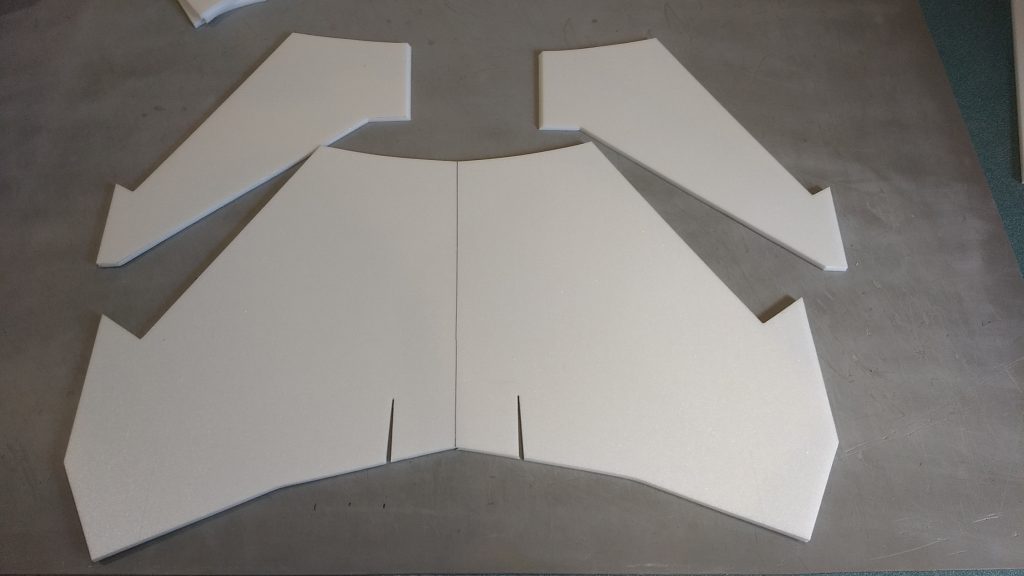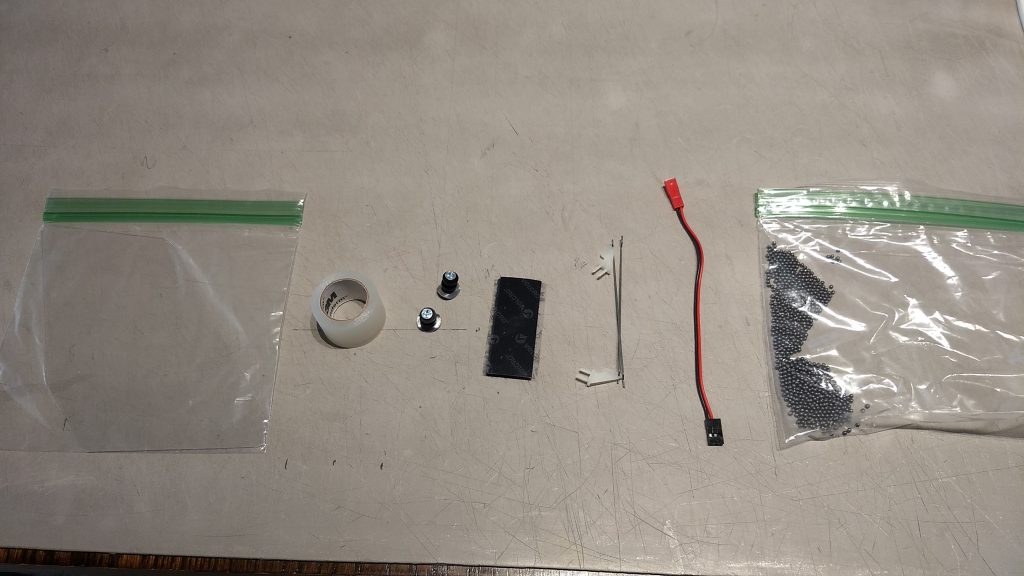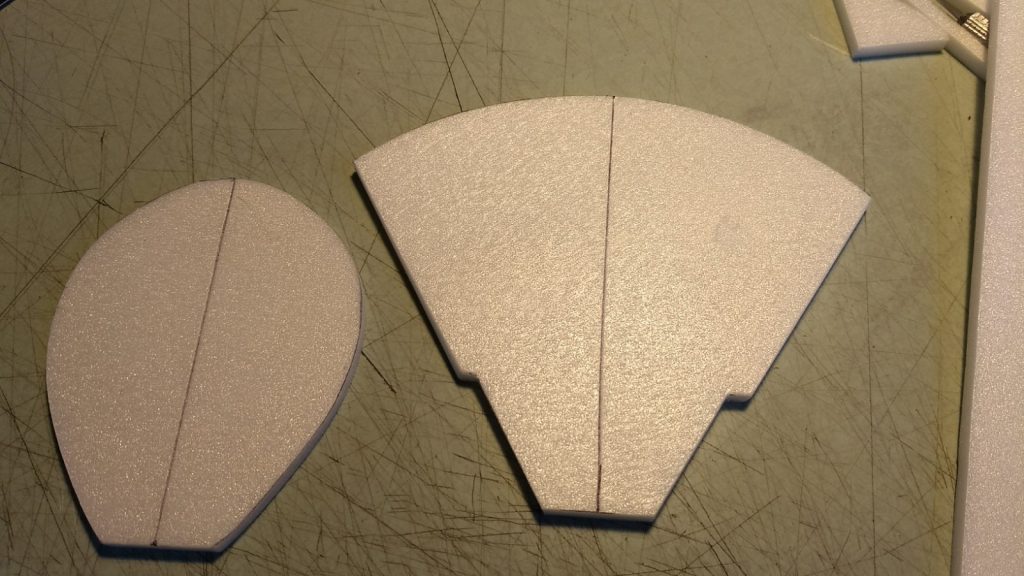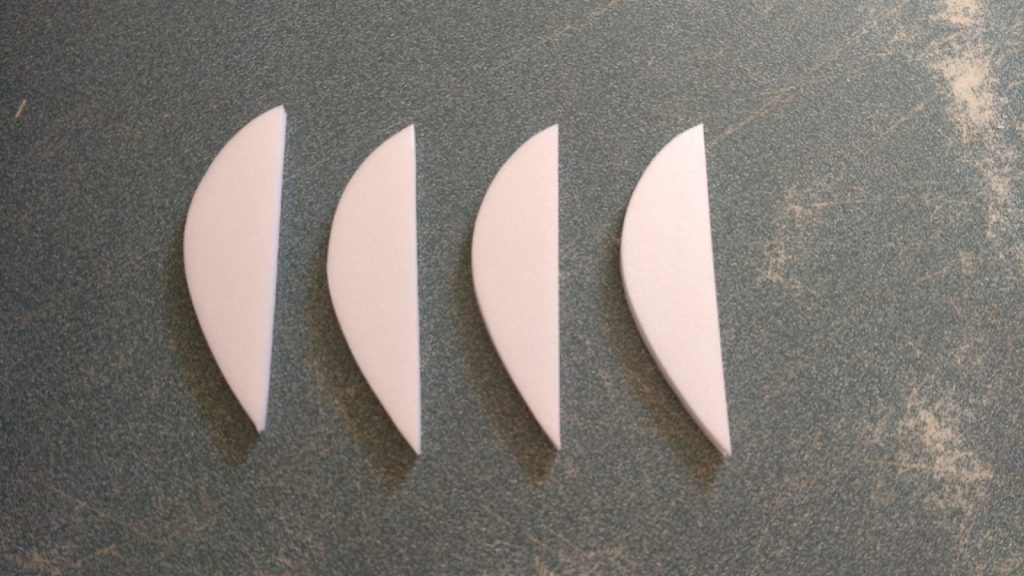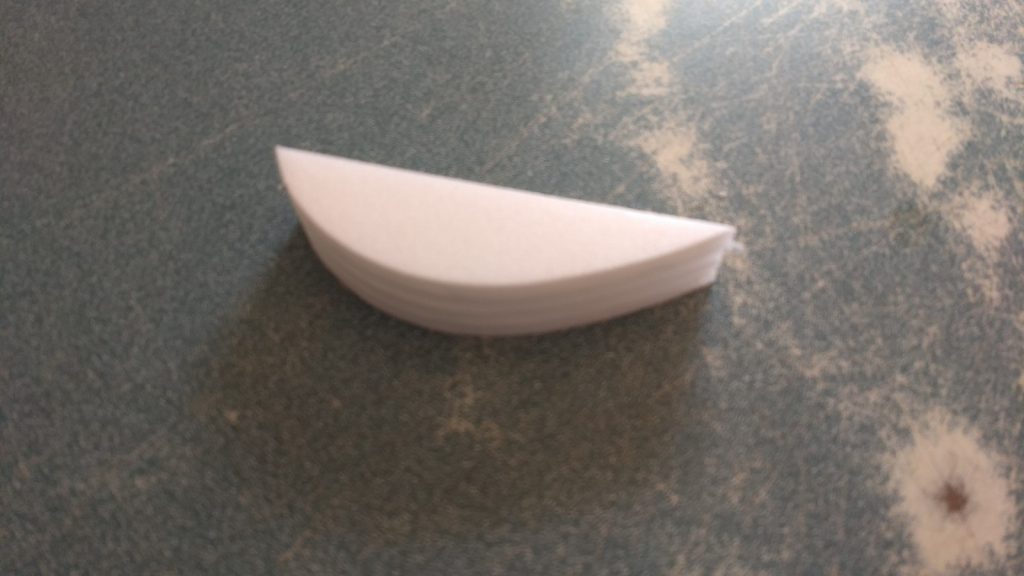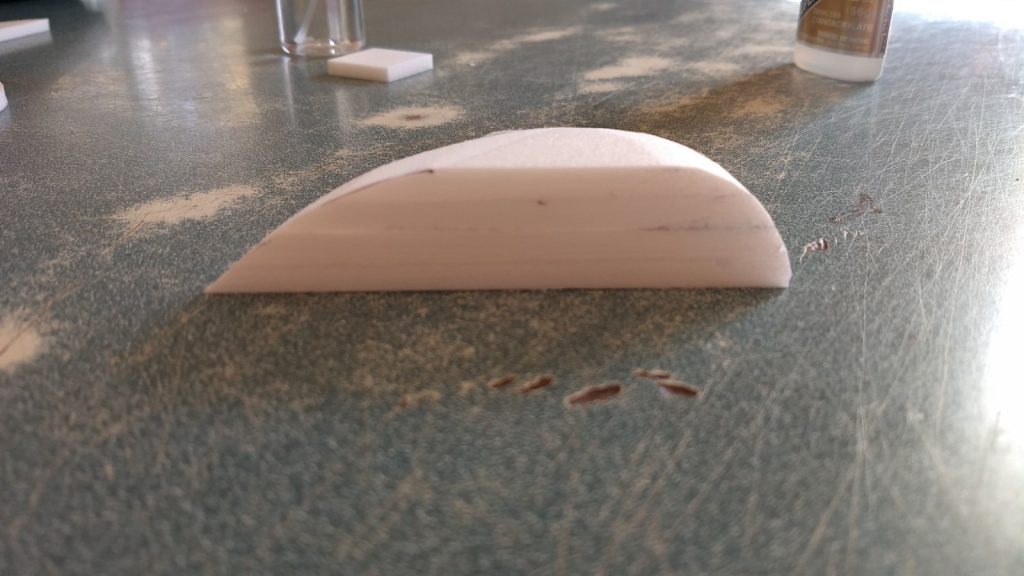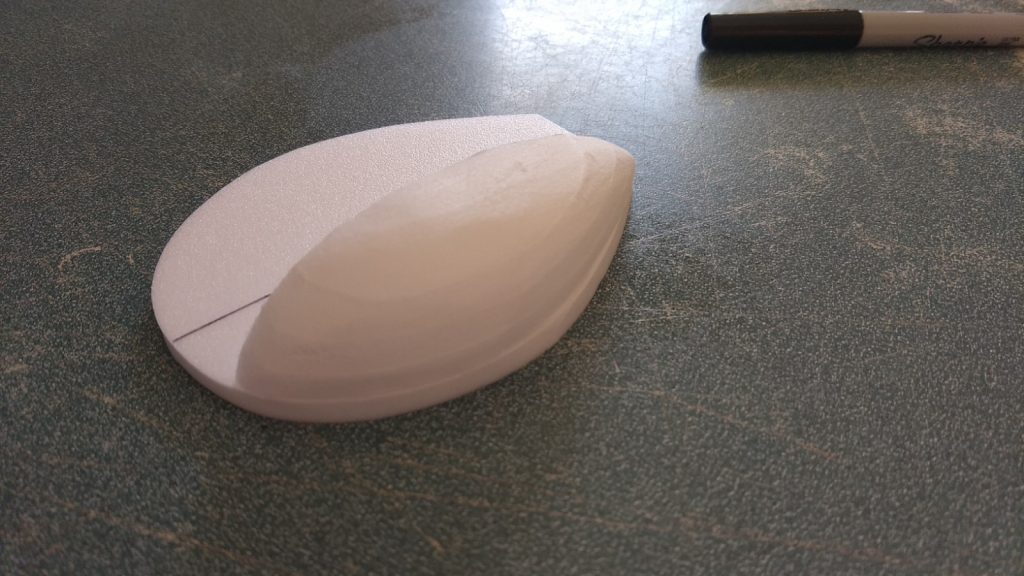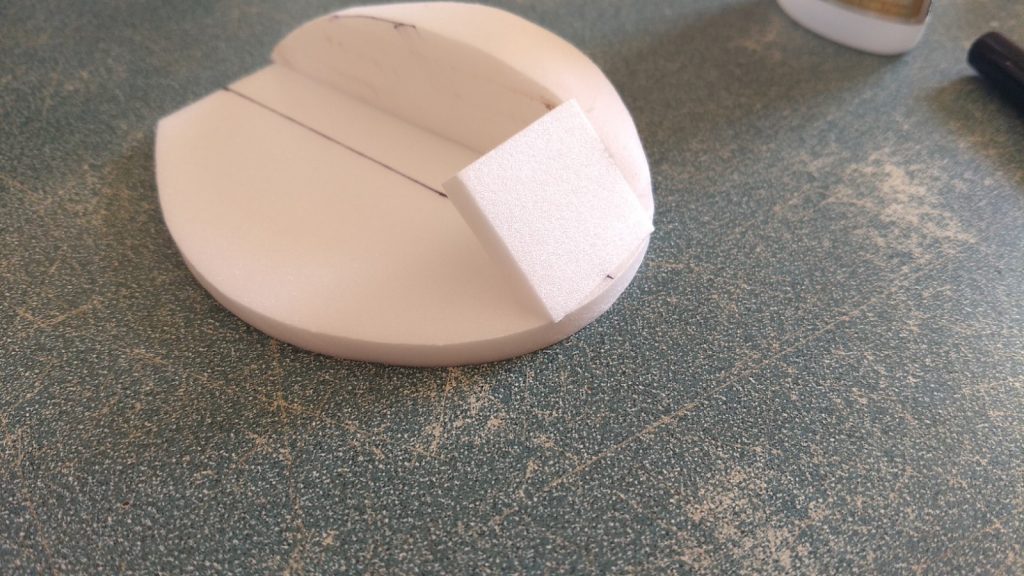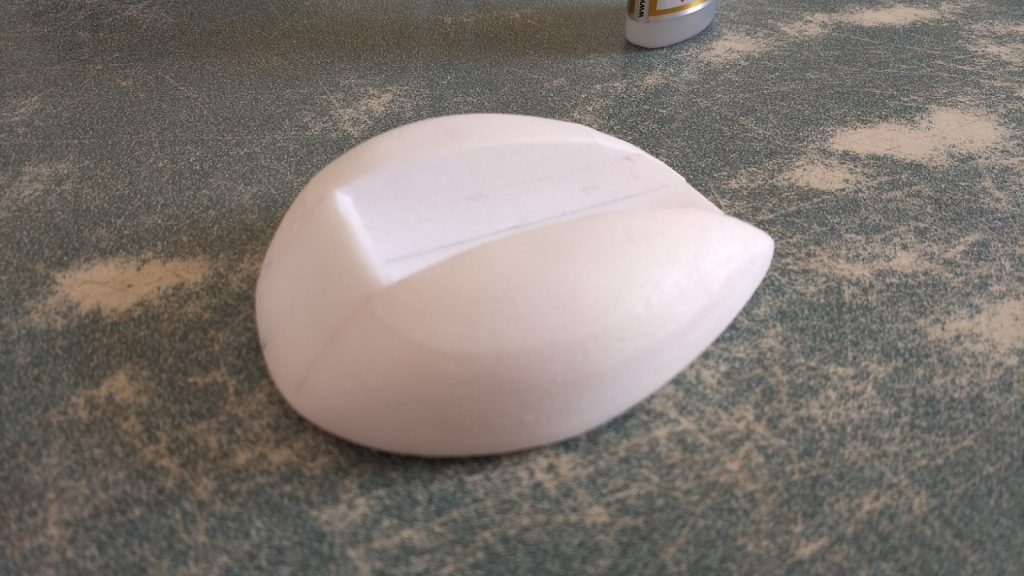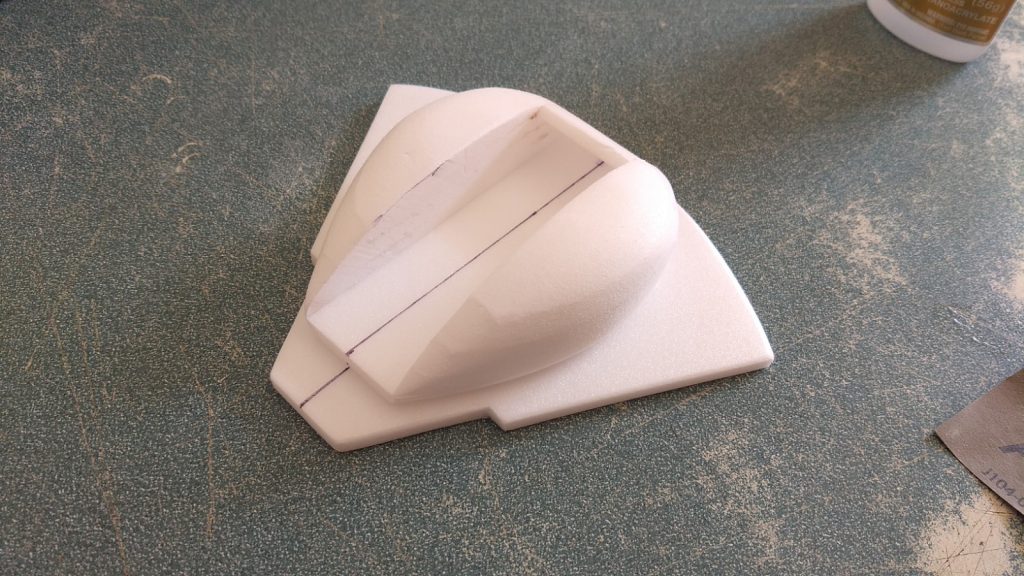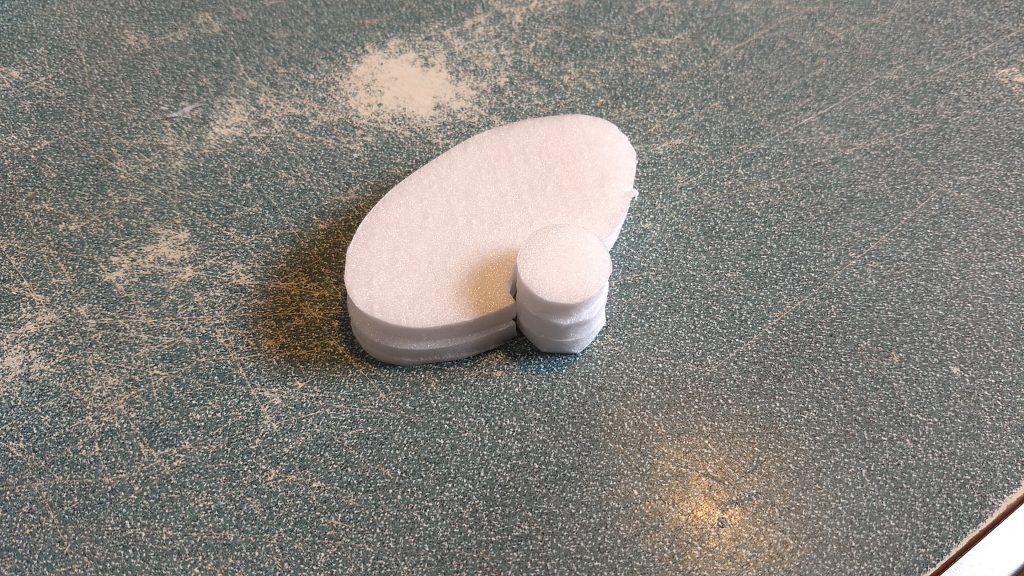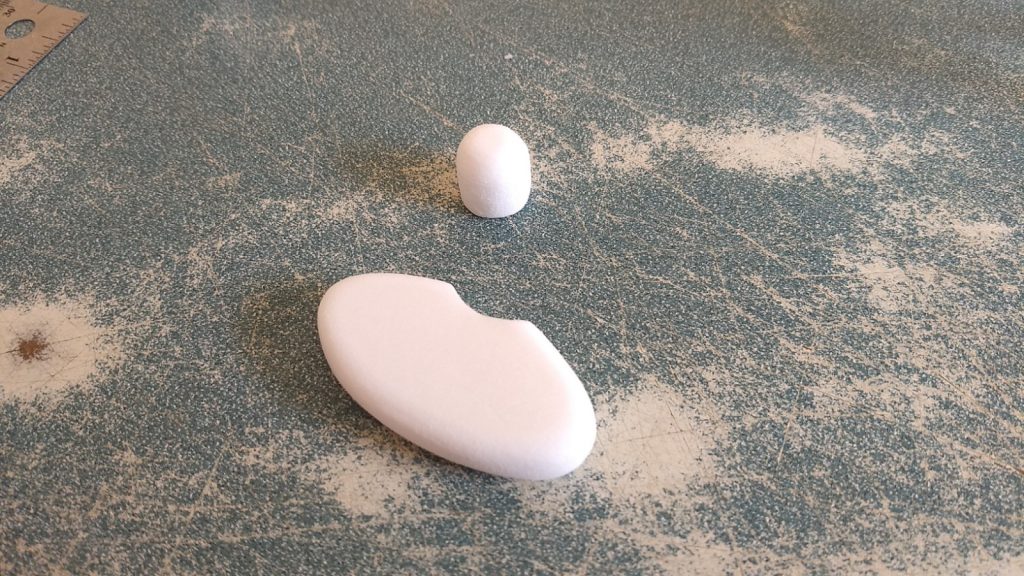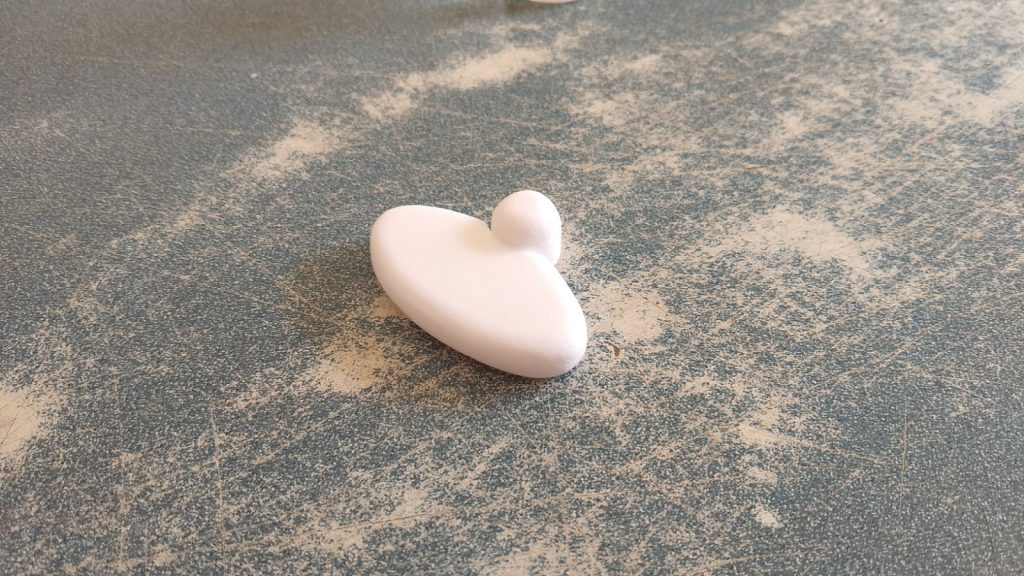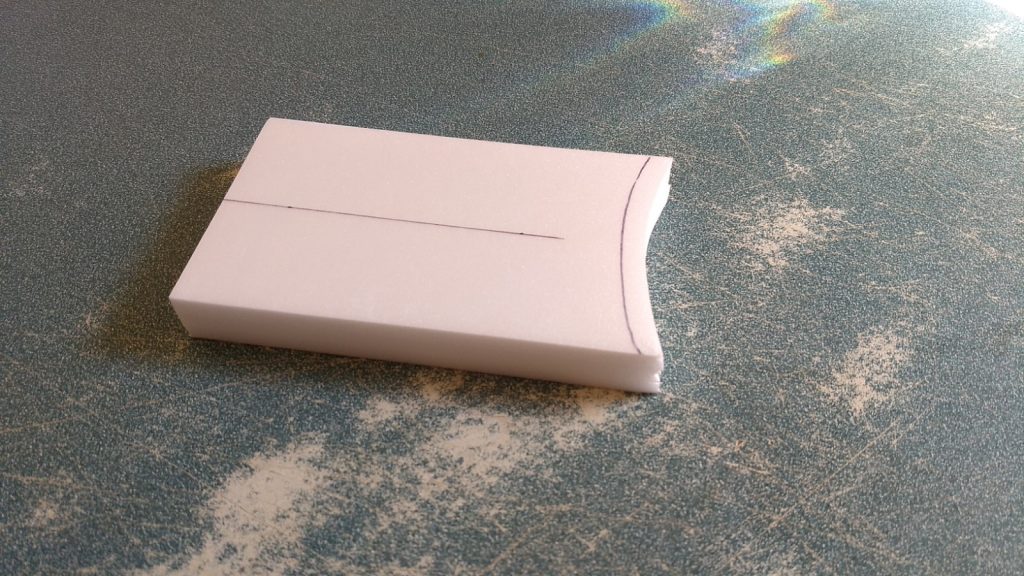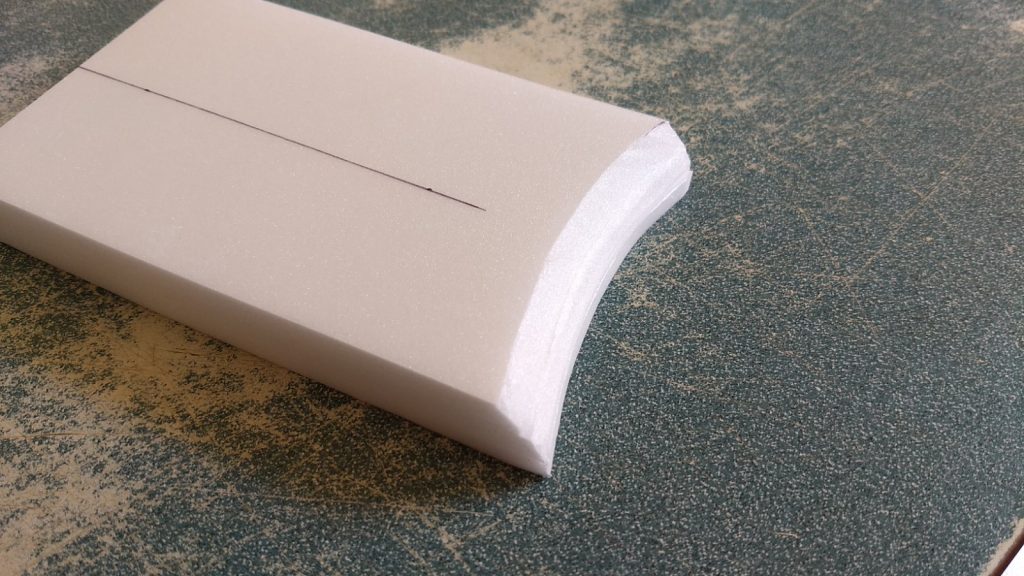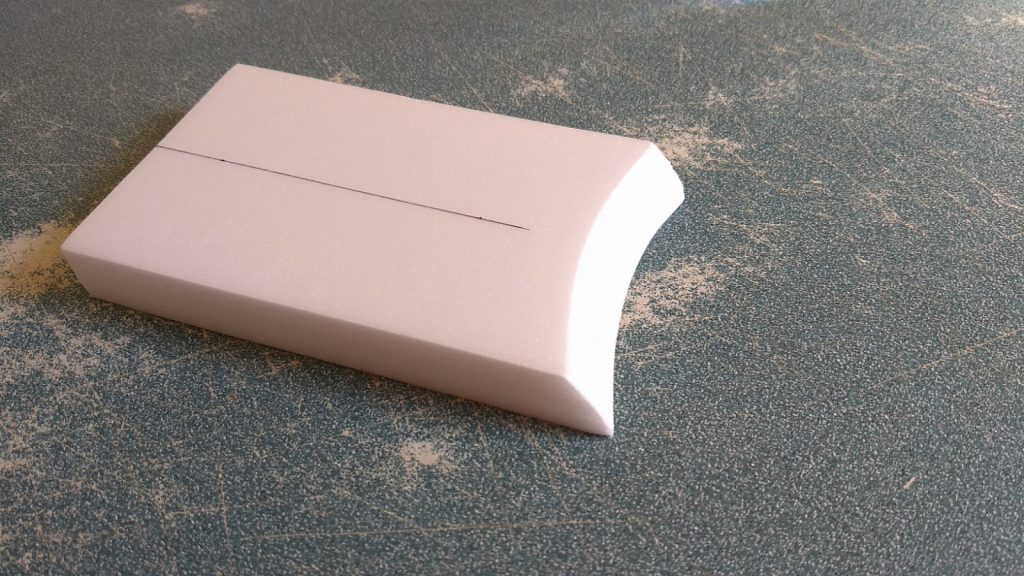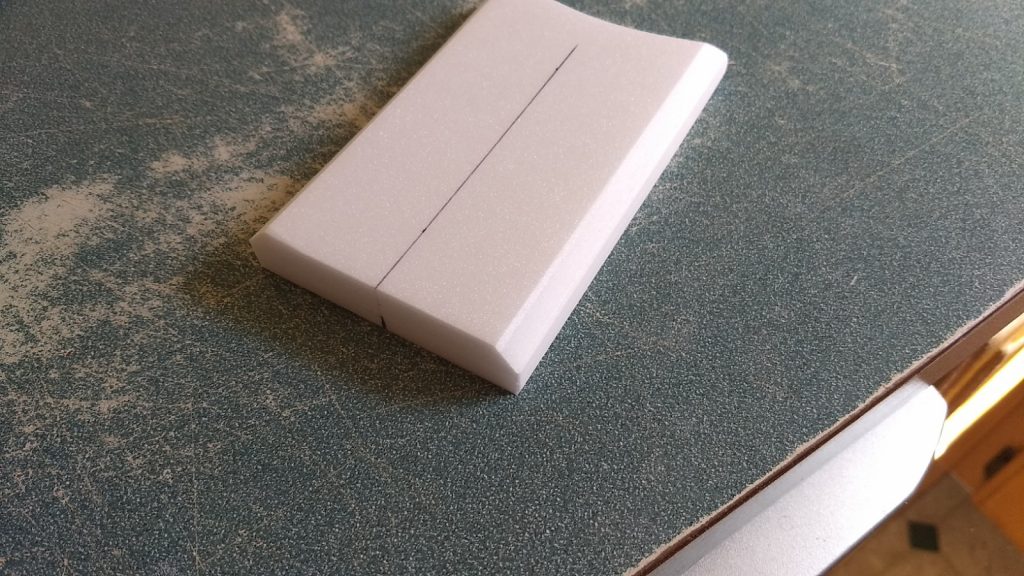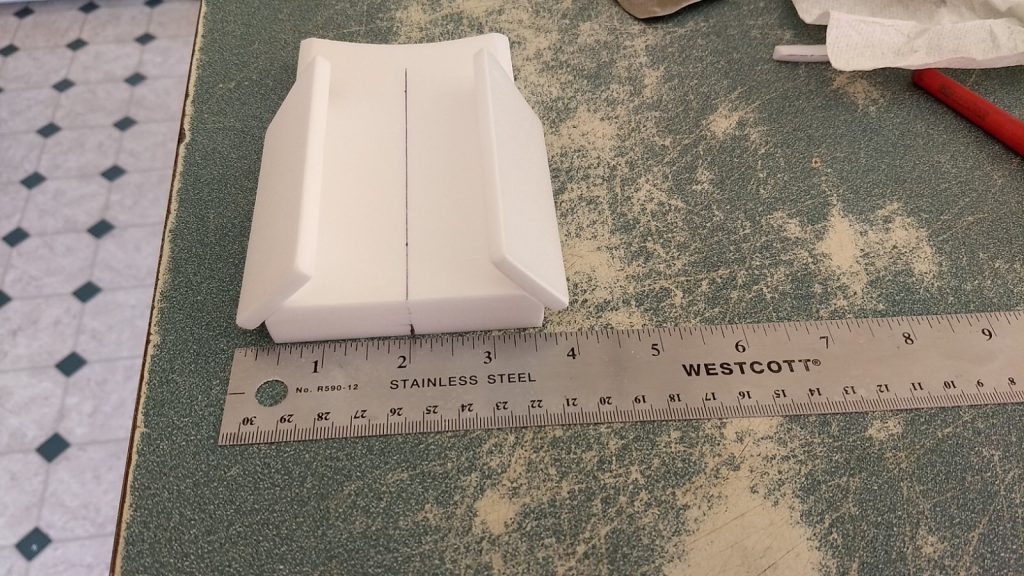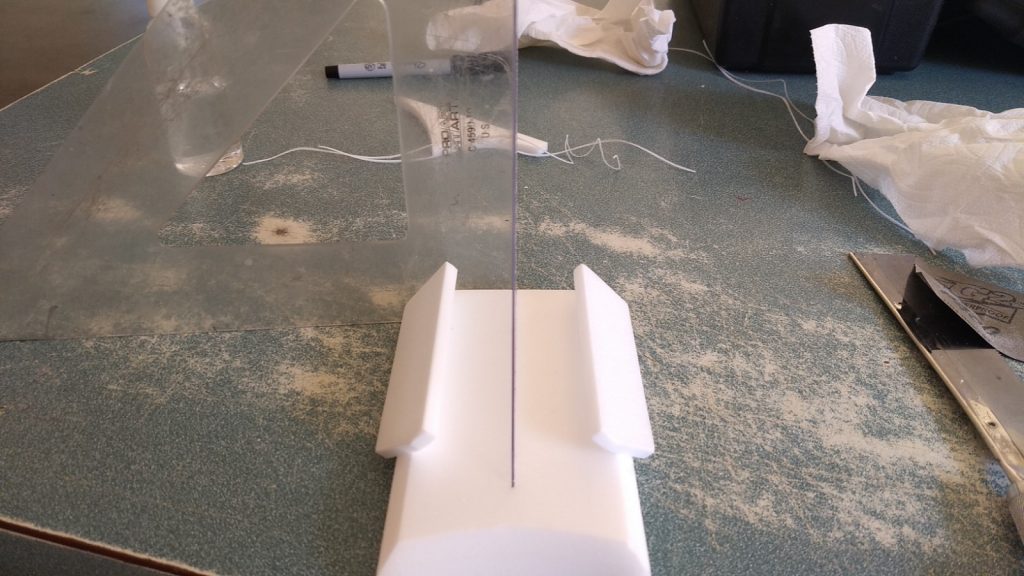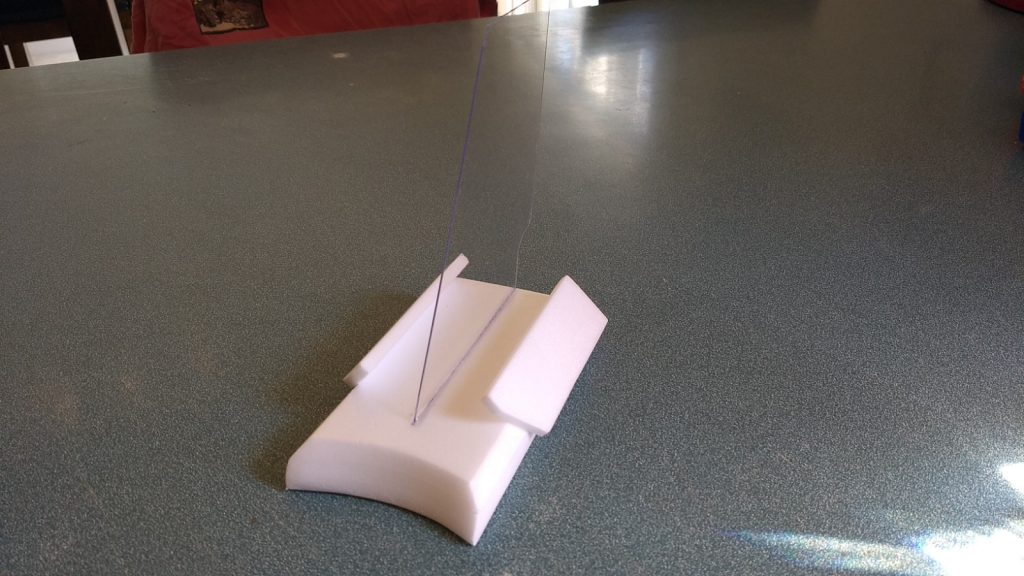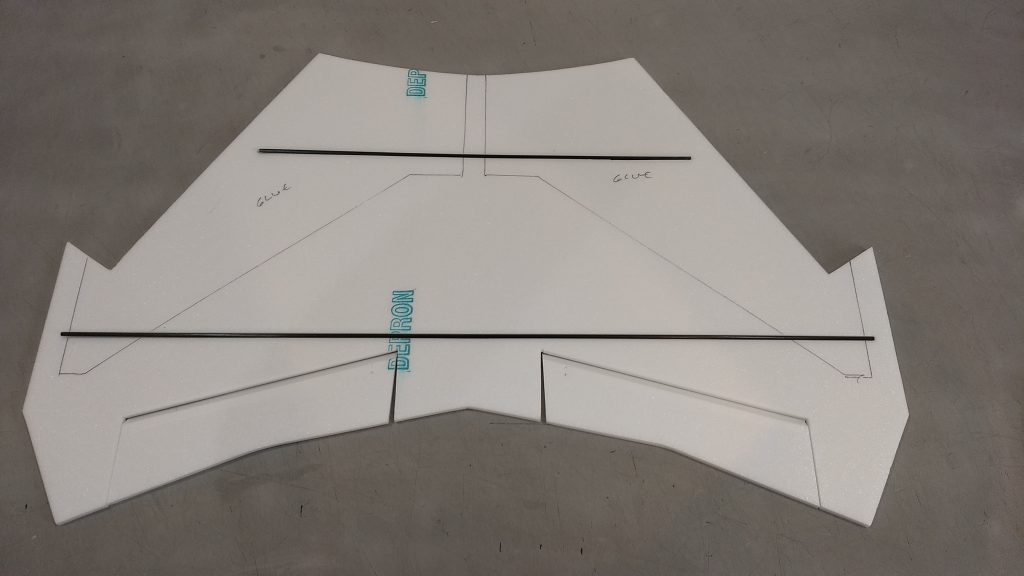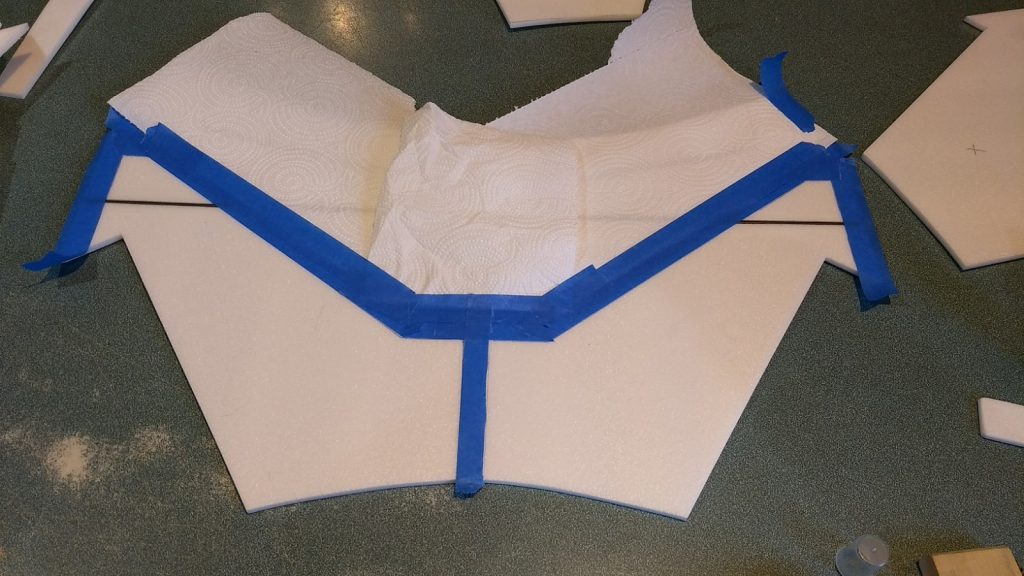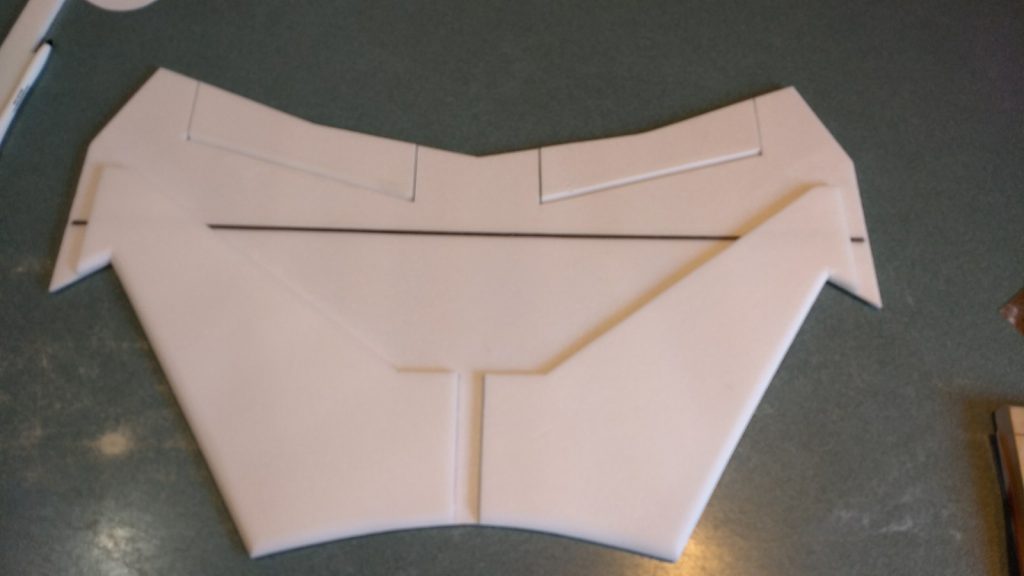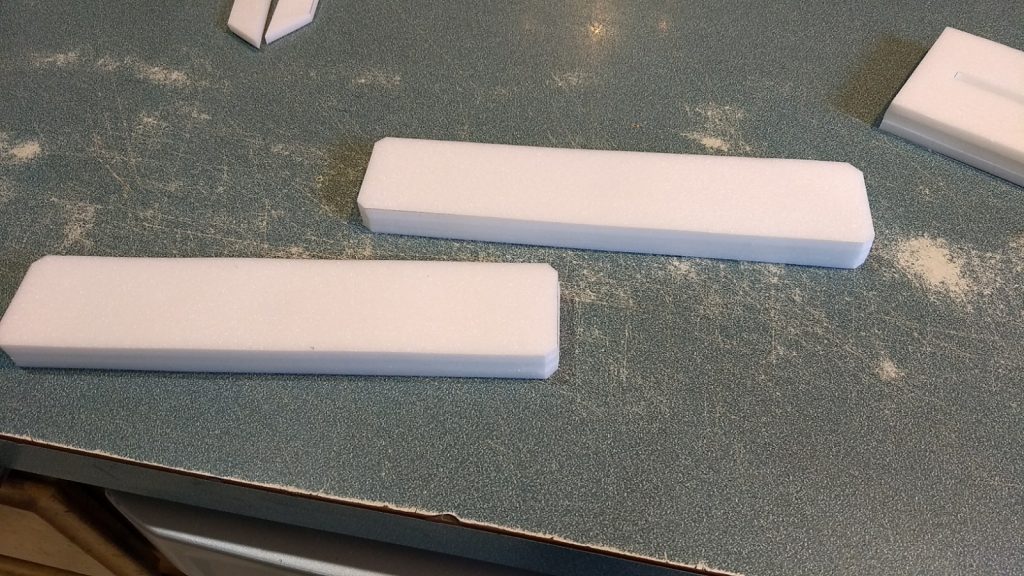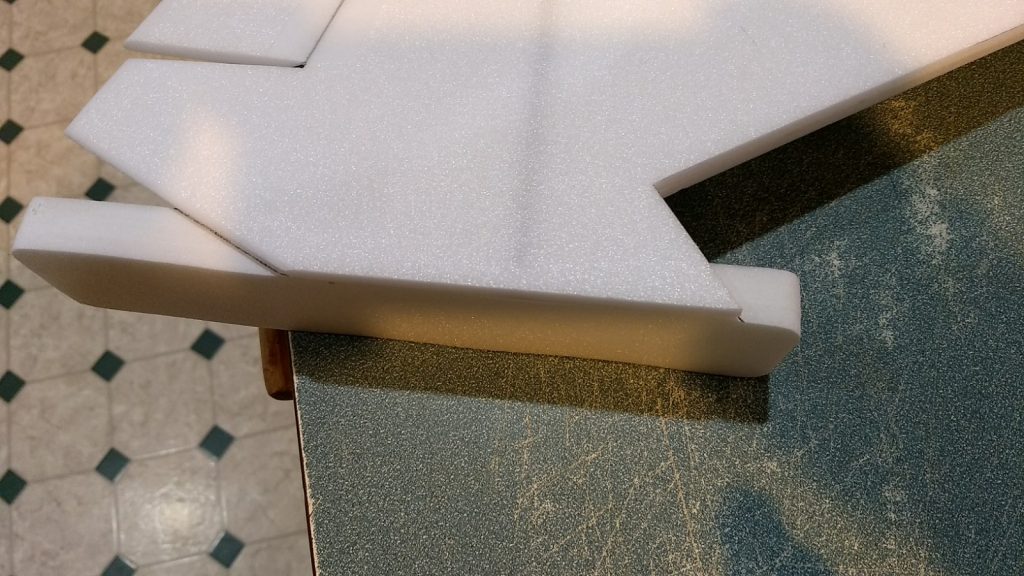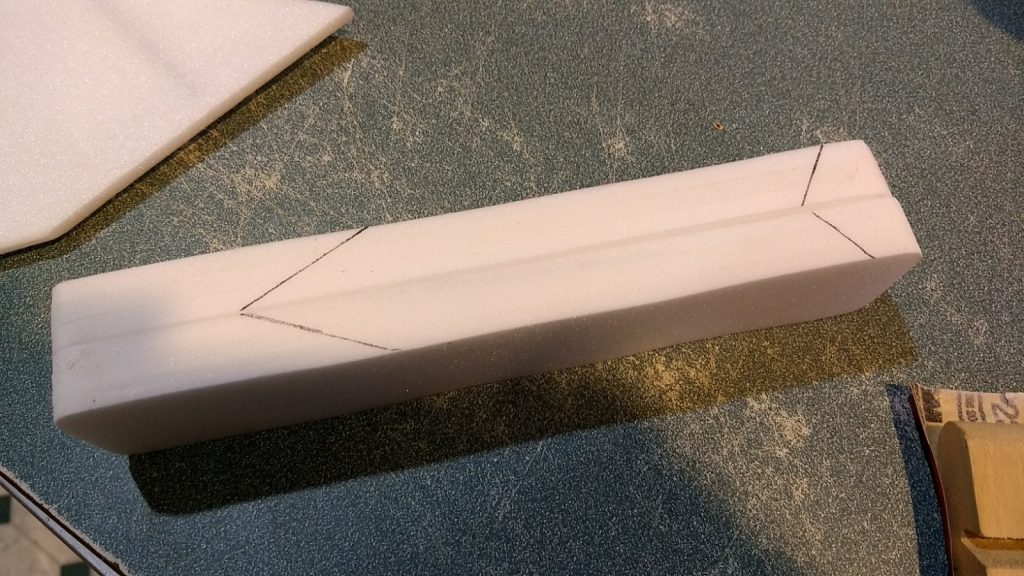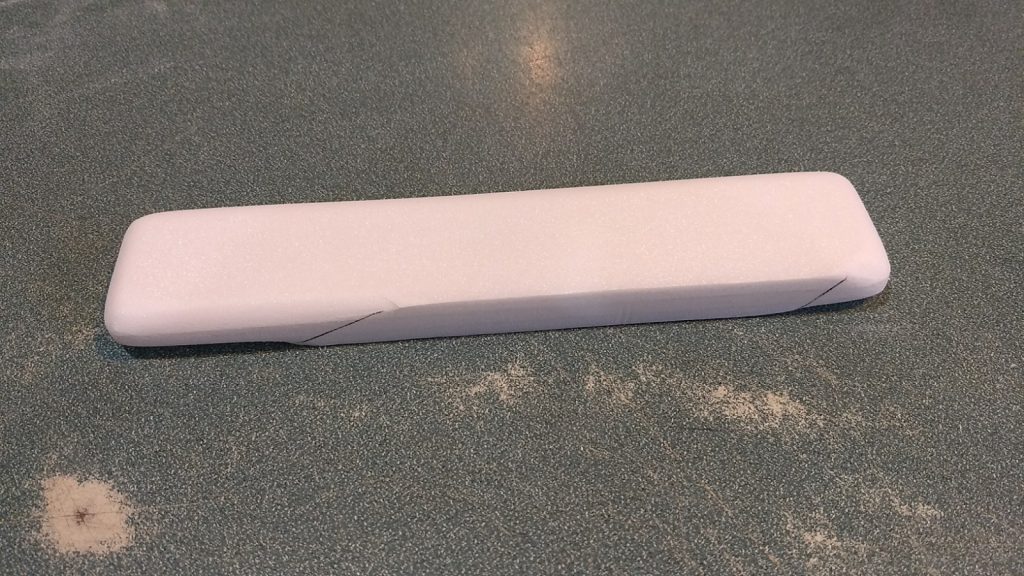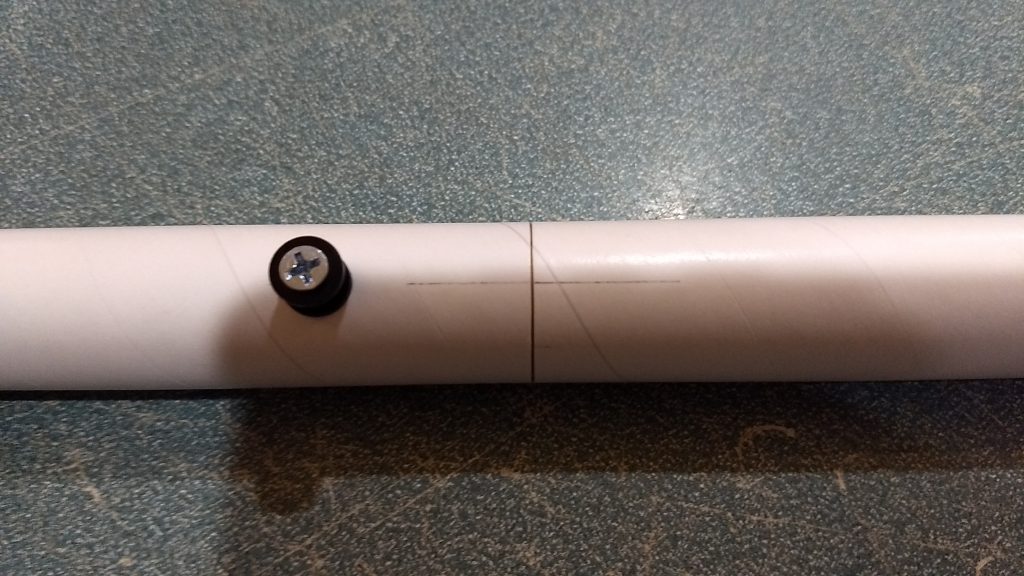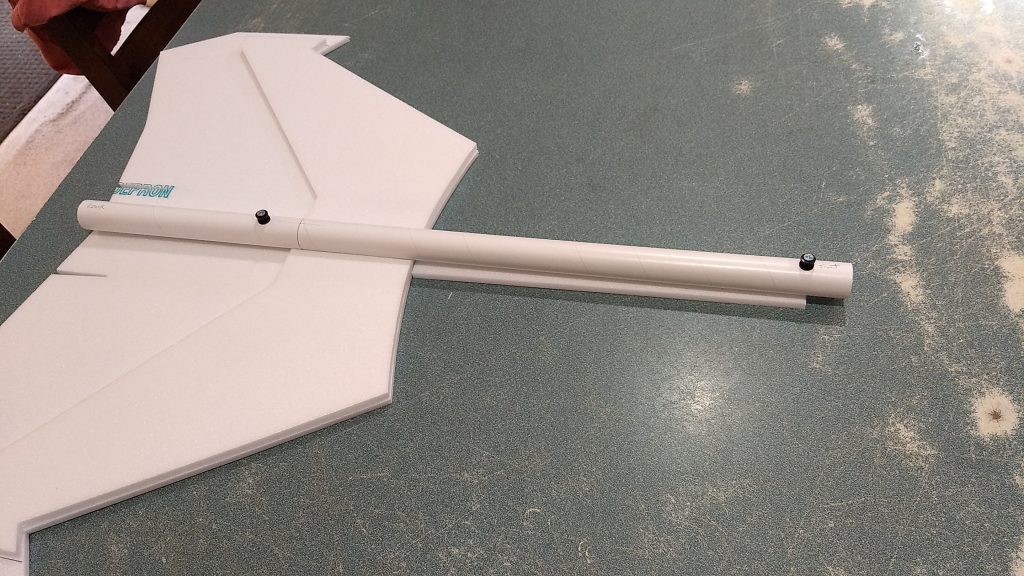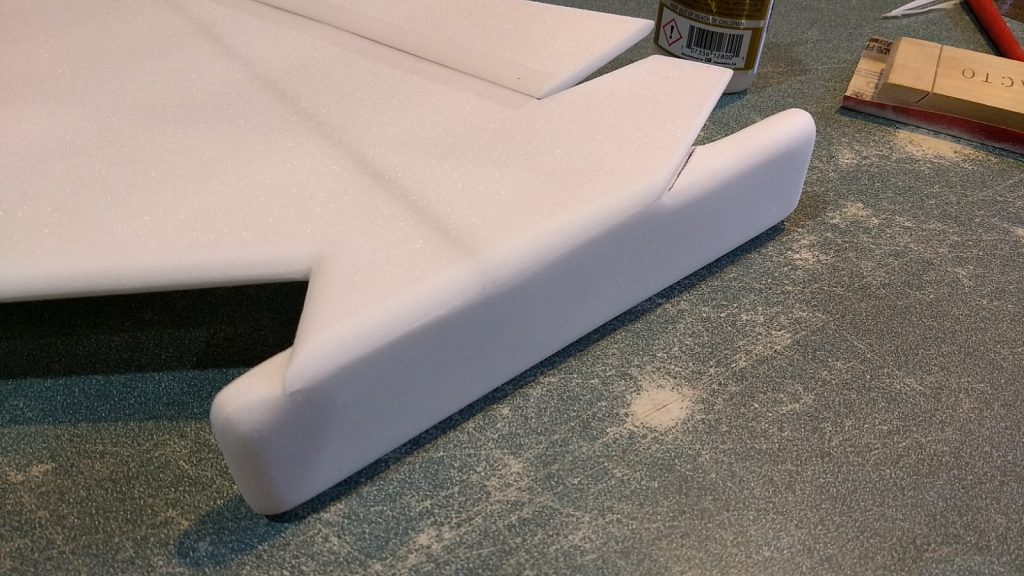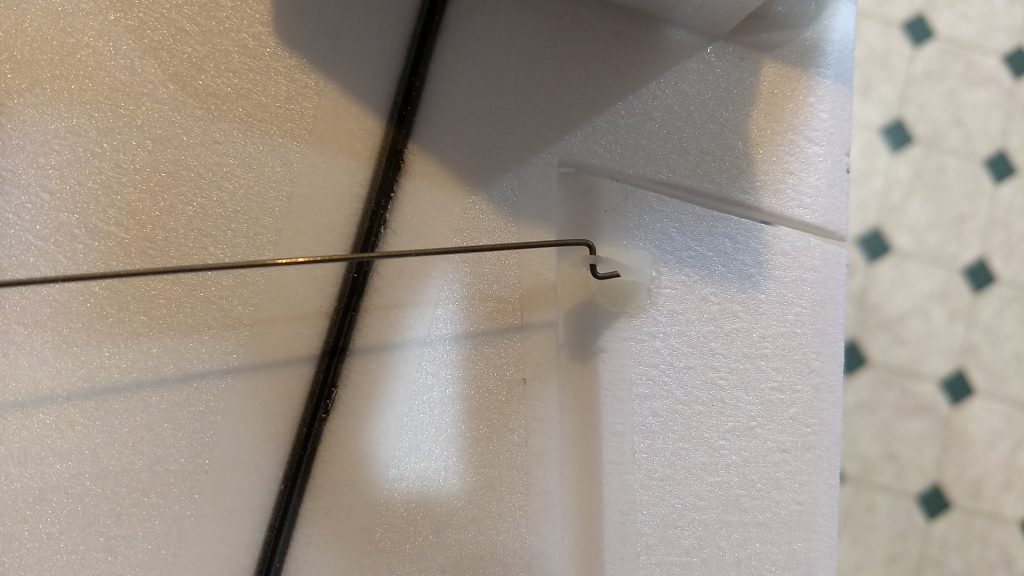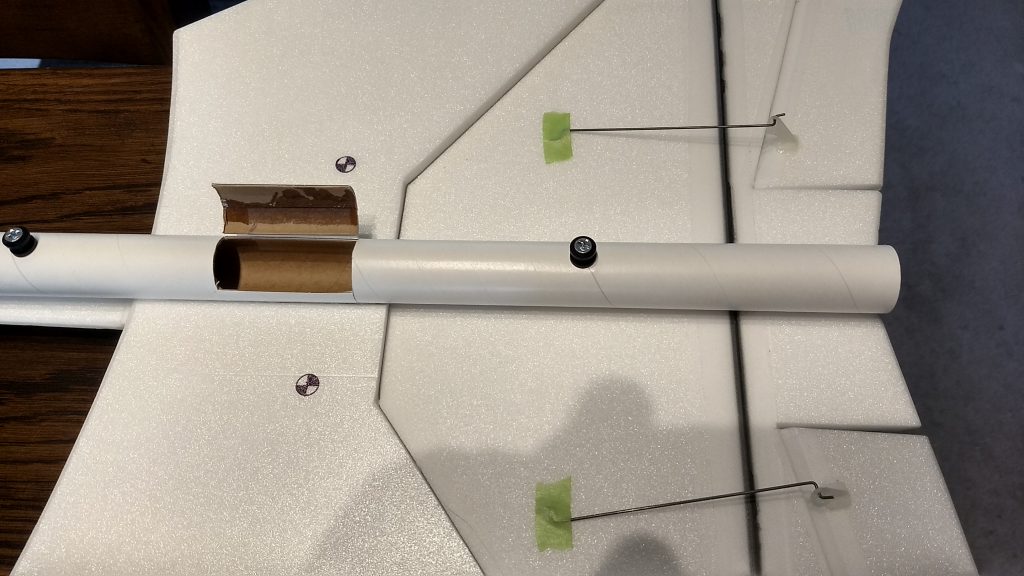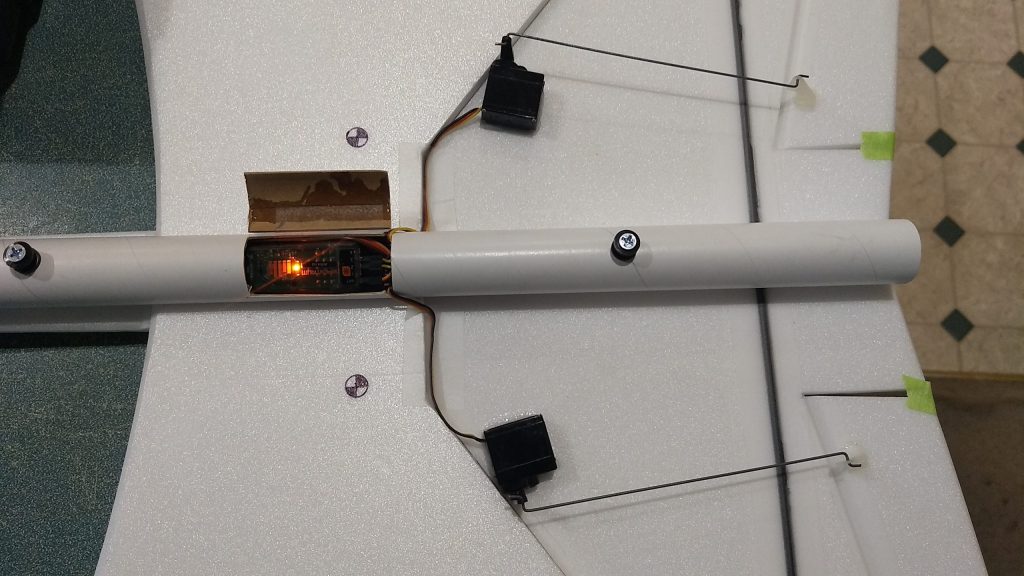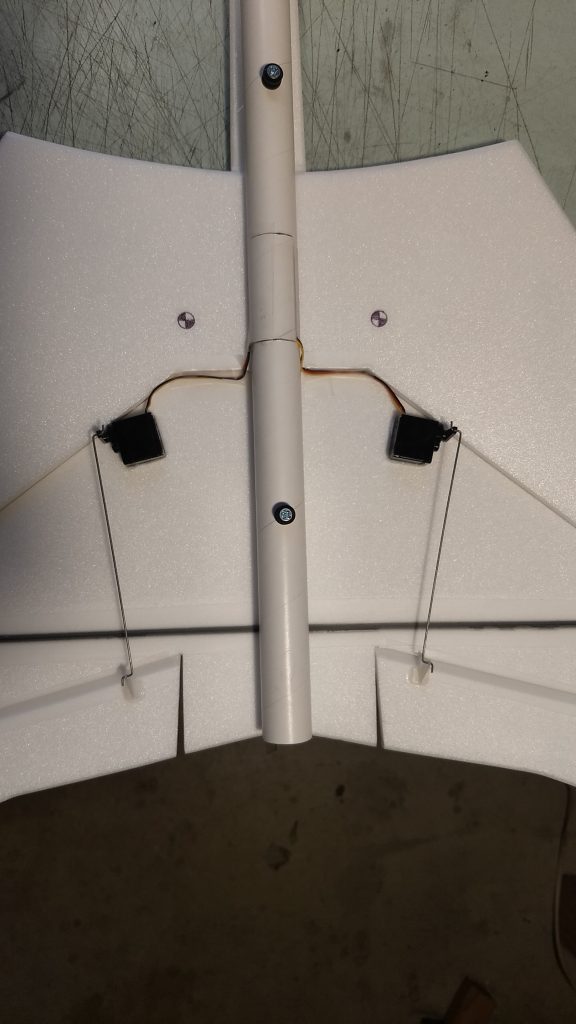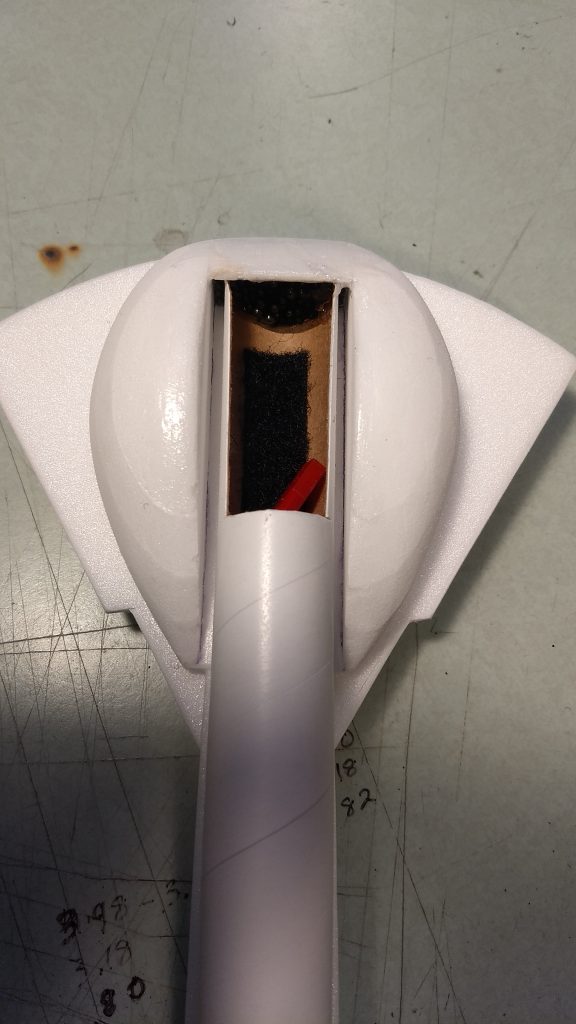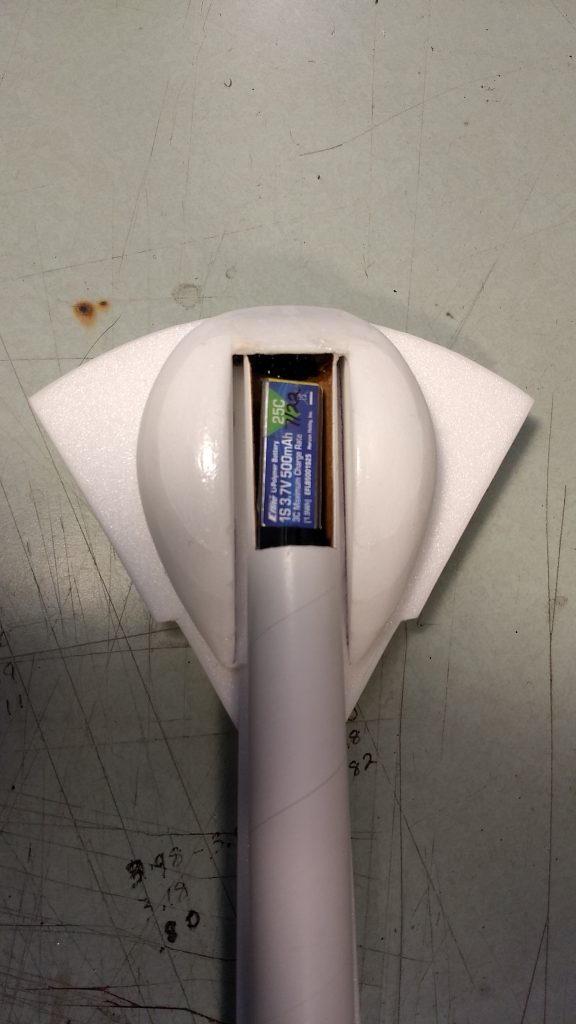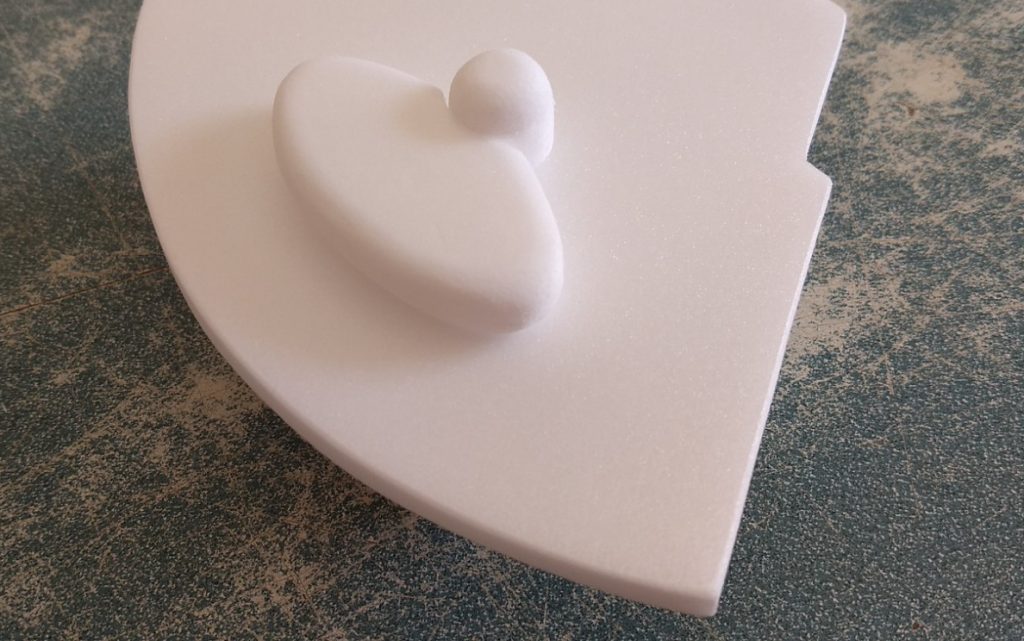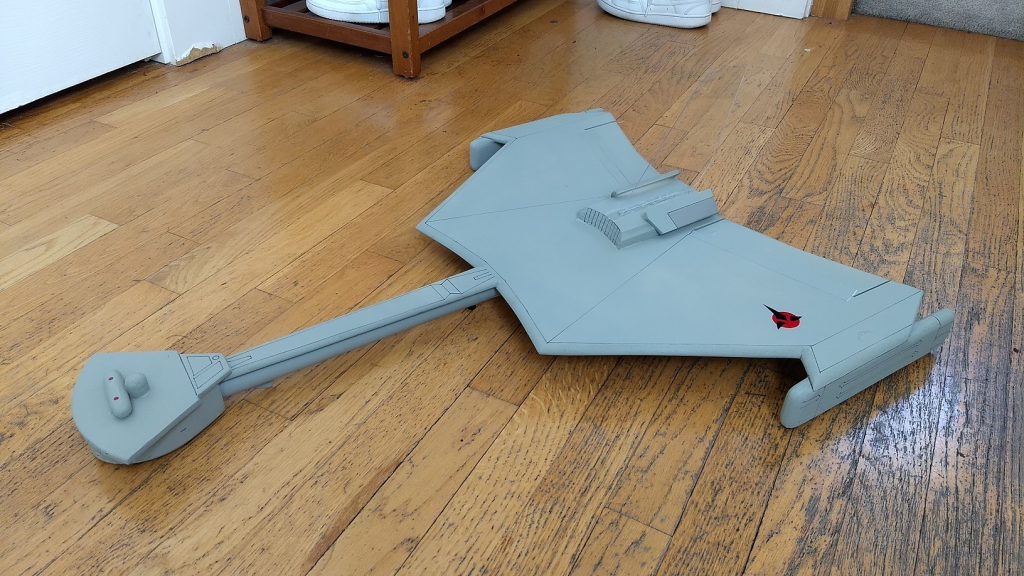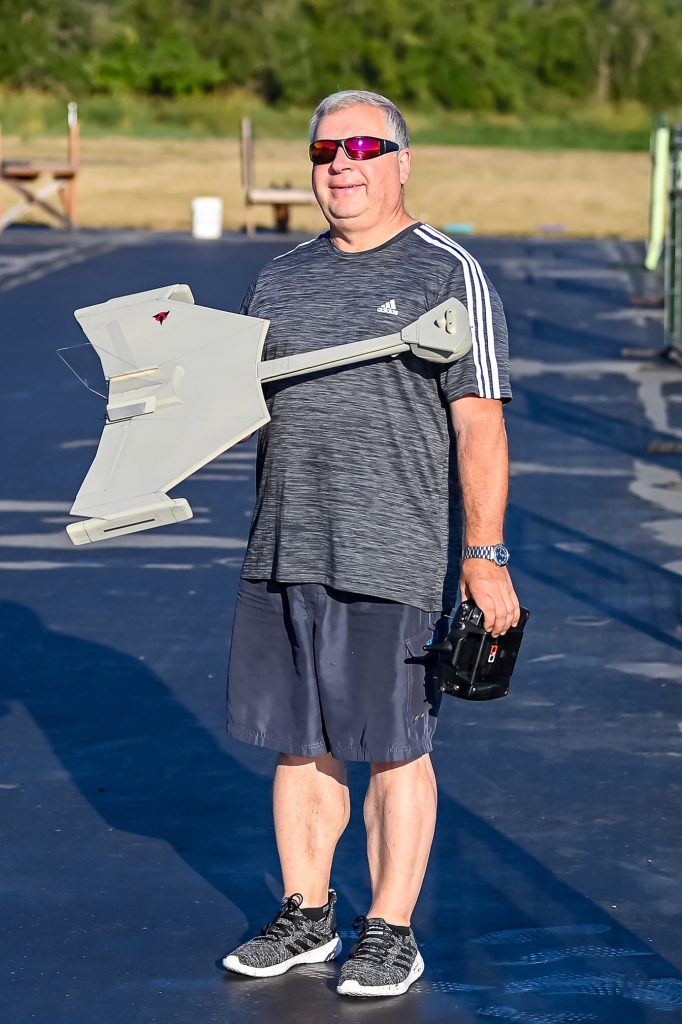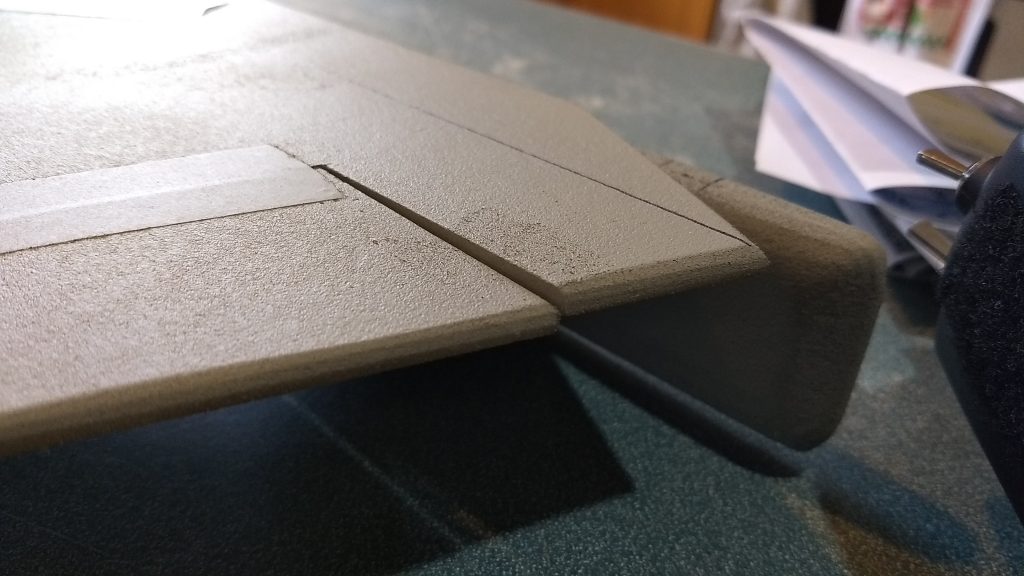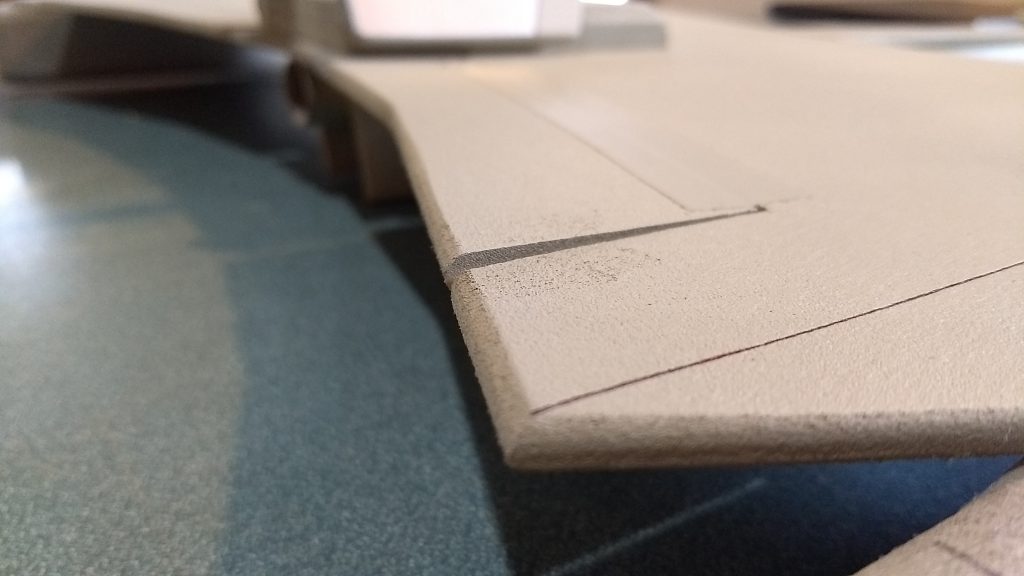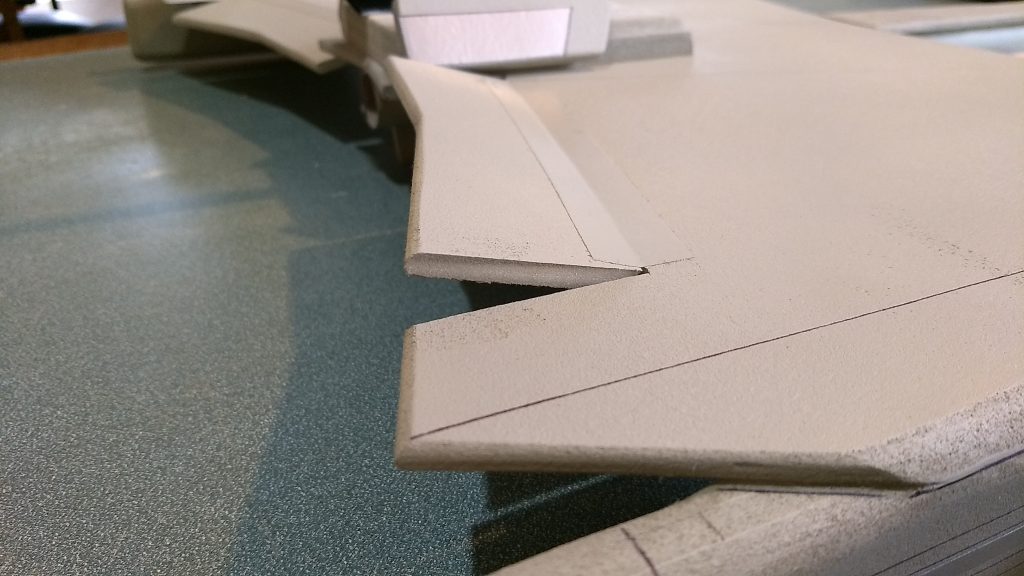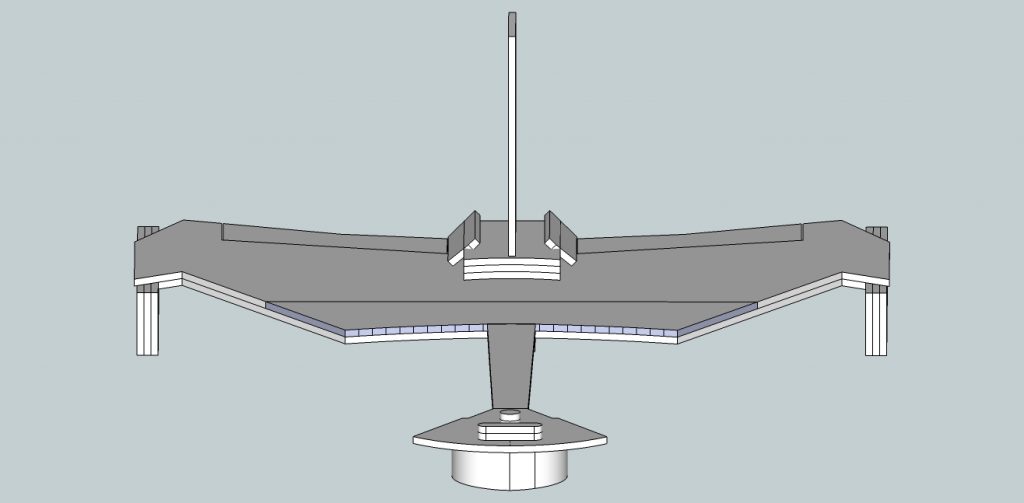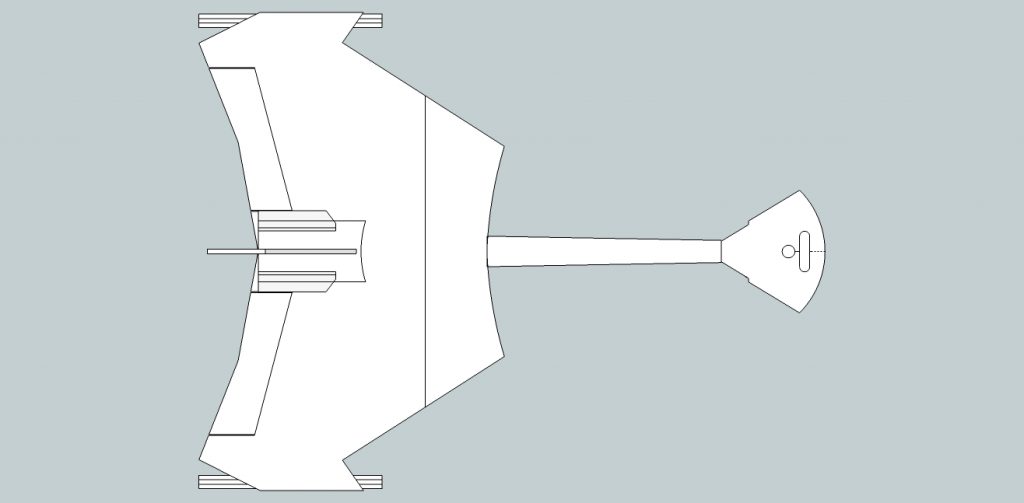
The D7 Battlecruiser RC Rocket glider kit is a new version of my original Battlecruiser kit with a clear tail and simplfied construction. It comes with white tubing for the body and 6mm depron wing and tail surfaces. Construction follows typical foam parkjet construction. You will need two 8-11 gram type servos, a 12″ lightweight servo extension, a receiver, and a small 500mah single cell lipo battery. For reloadable and single use E-6 rocket motors only. You will need a transmitter with delta or elevon mixing. You will need 5 minute epoxy, foam safe CA+ and 3m-77 spray contact adhesive for assembly. Please refer to the General instructions for all kits tab above, then read these instructions completely before starting assembly. Wingspan 23.5″, length 30″, weight 11 oz rtf.
CG location for rocket flight: 8 3/8” forward of the rear end of the body tube.
Welcome to the world of rocket boosted radio control gliders. This is not a model for a novice RC pilot, but anyone who is comfortable with RC flying of a medium speed model should be fine. Read through the instructions, look at the photos and be sure you understand the step and the correct parts and locations before commiting to cutting or glue.
Identify all pieces, the kit should contain:
Foam Pieces:
1 wing taped together 6mm
2 wing doublers 6mm
6 Warp Motor pods 6mm
8 Lower bridge sides 6mm
1 Lower bridge front plate 6mm
3 bridge detail disks 6mm
2 oval bridge details 6mm
3 vertical stab mounting plates 6mm (the part that the vertical stab will glue into)
2 vertical stab angle plates 6mm(that glue to the stab mount assembly)
1 Upper Bridge Plate 6mm
1 Inner Bridge Plate 6mm
1 fuselage neck 6mm
1 vertical stabilizer .035 polycrabonate
Other pieces:
1 long 3mm spar
1 short 3mm spar
1 24mm front long tube with rail button and coupler installed
1 24mm short rear tube with rail button installed.
2 control horns w/pushrods installed
1 roll blenderm tape
Velcro(for battery and rx/bec attachment)
Lead weight
spare depron
Notes before starting:
You may use 220-320 grit sandpaper and a sanding block to round the edges of the foam on the fuselage neck, and to lightly break the edges of the angle plates as well as the wing and nacelle pods as per the instructions. It just makes them look a bit nicer. Do any sanding before assembly or as suggested at the correct point in the instructions.
Assembly:
- The model was designed to use foam safe CA+ glue and accellerator(I use bob smith brand), 5 minute epoxy(only on the clear stab!), and 3m-77 spray adhesive only. If the instructions say “glue” that assumes using foam safe CA+ the 3m-77 will only be used for specific steps.
- Take a few minutes to look at the assembly drawings below and the parts photos and understand what parts are called and where they will go.
- Draw a line down the middle of the upper bridge plate and Inner bridge plates.
- Glue four of the side bridge pieces together to make an assembly and repeat to make a second one.
- Mark the side of each side assembly to a teardrop shape and sand the side view to match.
- Carve/Sand the outer corners of each assembly rounded, make sure to make a left and right.
- Glue one side assembly to the inner bridge plate lining up the outer rounded edges.
- Glue the front bridge plate to the inner bridge plate and the side assembly. Note this piece has an angle cut that glues to the inner bridge plate and will be sanded to match the sides when complete.
- Glue the other side assembly to the inner bridge plate and front plate.
- Sand the front plate and side plates to a nice pleasing round shape.
- Sand the top of the inner bridge plate assembly to a nice rounded edge.
- Glue the inner bridge assembly to the bottom of the bridge top plate so that the front of the assembly is almost even with the front of the top bridge plate.
- Glue the three circles together for the bridge detail. Glue the two oval bridge details together. Sand the top of the circle stack round and round all sides of the bridge detail piece.
- Glue the round stack to the rounded cutout in the oval bridge assembly.
- Glue the three Vertical Stab Mounting Plates together.
- Lightly sand the three straight sides so that they are smooth.
- Sand or cut with an exacto the front curved portion of the stack back at an angle about 1/4″ wide and sand it to a nice smooth radius. This is just decorative, the angle doesn’t matter.
- Sand or cut the two top side corners of this assembly at a 45 degree angle that is approx 1/4″ wide.
- Sand the two small vertical stab angle plate edges slightly to break the corners then glue them even with the rear of the stack one on each side against the angle you sanded earlier. The angle pieces should not stick out very far from the sides of the stack at the bottom or they will interfere with the elevons. See the picture. The width of the assembly should not be more than 4″ wide at the bottom.
- Cut a vertical slot in the assembly down the middle so that the rear of the stab will be even with the rear of the assembly when inserted. The slot will start about 3/4″ or so back from the front of the assembly. Only cut through the first two layers, make sure the stab fits and is vertical.
- Lightly sand the bottom 3/8″ of the stab root then glue it into the slot with a small amount of 5 minute clear epoxy making sure it is vertical.
- Unfold the wing and glue the joint using foam safe CA+. The side with the spar slot is the bottom and will be up for the next steps.
- Glue in the spars then tape over with blenderm tape.
- Locate the wing doublers. One will be glued to each side of the wing, the leading edges will be aligned, note there should be an approx 3/4″ ” gap between the two sheets in the middle for the body tube. The doublers don’t go out to the wingtips so that they make a step to help align the warp pods when gluing. Using masking tape and some wax paper or paper towels, mask off the areas of the wing that are not covered by the doublers. Using 3m-77 spray, spray the doublers and the wing and remove the masking. Note when you spray the doublers there needs to be a right and left side so make sure you spray glue on the correct side to make a pair. Apply each wing doubler in place taking care to keep it aligned with the leading edge of the wing. CA Accellerator can be used to remove overspray on the foam with light wiping. Once they are installed you may sand the leading edges round or cut a bevel if desired, I put a bevel on the trailing edges using an exacto and straight edge, just 1/16″ wide or so top and bottom. Do not round the wingtips at this time. Lay the wing upside down on a table so that the spar and doublers are up.
- Mark a line down the center of the bottom of the foam neck piece. This will be used for aligning it with the wing centerline joint. If you sanded the leading edge of the wing round, you will need to sand the rear of the neck piece at an angle so that it will make good contact with the wing. Place a piece of waxed paper under the wing, and using a straight edge make sure the neck makes good contact with the wing and that it will be straight with the centerline of the wing. Making sure the wax paper is under the glue joint, glue the neck to the wing keeping it straight. It is very fragile at this point till you glue the body tube down so handle carefully.
- Find the two body tubes. One has a coupler installed and is longer with a rail button at the front, the other is short with the rail button closer to one end. Slide the rear short tube with the end nearest the rail button onto the coupler on the long tube. If you get the rear tube backwards the motor won’t slide into the rear end! There is an alignment line on the two tubes, use this to keep the rail buttons aligned. No glue is needed, when you glue the tube assembly to the wing and neck it will lock them together, the coupler is just there to provide stiffness for the neck.
- Test fit then glue the body tube assembly so that it is even with the rear of the wing, makes solid contact with the wing and neck and is level and straight. Make sure the short tube is in the back and the rail buttons are pointing straight up. Make sure the neck is centered on the body tube at the front. The tube will stick past the end of the neck, that’s ok the bridge will glue to the tube later.
- There are six long rounded rectangles that form the warp pods. Using the 3m-77 spray adhesive you will laminate 3 pieces together to form the warp pods. You spray the 3m-77 on both pieces, let dry for 1-2 minutes then press them together. You cannot separate them after touching them together so make sure you do this carefully. If there is any warp in the pieces try to reverse the pieces before gluing so that the warp will be removed. Then spray and laminate the third piece together with the two you just laminated. You want these to be as flat as possible. Sand the edges even and flat. Repeat for the other pod.
- You will then mark the pieces so you know where to sand them round. Each warp pod should be placed so that the outside is even with the wingtip end, and the warp pod sticks out 1/2″ to 3/4″ forward of the outboard wingtip at the front. Using a sharpie, mark where the warp pod will be glued. This part will stay flat and unsanded. Carefully round all other edges, you may want to use an exacto and a straight edge to trim the corners that will be sanded at a 45 degree angle lightly to make the sanding go faster. You will need to do the same thing for the other warp pod on the other side. Set these aside. Note you have to make a left and right warp pod!
- The warp pod assemblies glue on the wingtip against the wing doubler. Make sure they make full contact and are straight compared to the fuselage tube. Glue a pod on each side.
- Sand the wingtip round to blend it into the warp pod, then lay the wing upside down again.
- Apply CA+ to each of the control horns and press them in place in the bottom of each control surface into the pre-made holes. Note pre installed control pushrods go on the inside of each control horn nearest the body tube The holes in the horn face forward and the pushrod should be closest to the body tube. Apply a fillet around the control horn and the top of the prongs on the top of the wing.
- At this time it is easier to go to radio installation since the wing can sit flat on the table while you install the radio gear.
Radio Installation
Note: Your radio needs to be configured for Delta mixing, this means that the servo arms will move the same direction during elevator stick movement and opposite for aileron stick movement. Connect your servos to the receiver one in the aileron connection and one on the elevator connection and apply power. Use a servo arm at least 9/16” long and with holes small enough that there won’t be slop with the pushrod wire when installed. I use the hole furthest out on the servo arm, to maximize movement. On some servos there are a long two-ended servo arm, you can use this arm and trim off one end. Zero out any trim settings on the transmitter.
- Connect a servo to each pushrod. If the pushrod is too tight, you can use twist an X-Acto knife in the servo arm hole to make it larger, but be careful and do not make it too large. Once connected, lightly tape each servo in place so that the control surfaces are centered. Flip the model right side up and look at it from the rear. Moving the transmitter stick back(up elevator) should move both elevons up. Moving the transmitter stick to the right should move the right elevon up and the left elevon down. If you can’t get the servo reversing to give you the right polarity try swapping aileron/elevator inputs to the receiver or turning the servos over and swapping the servo arms to the other side of the output shaft. If that is correct, continue.
- Flip the model upside down. The servos are attached to the model by gluing the servo to the wing with foam safe CA+. Double back servo tape can loosen over time and with exposure to heat, I prefer to glue the servo in place. With the radio still on, put a moderate amount of glue on the servo, being careful not to get any near the output shaft, and set it in place on the model keeping the control surface centered. Do the same to the other side. Make sure the glue is set before continuing. Note** The servo electrical wire should point toward the front of the model, you want the pushrod to be perpendicular to the hinge line, the servo will be near the edge of the wing doubler. See the photo for an idea of how it should look. The servos will be 2″ to 3″ away from the fuselage.
- Connect a 12″ lightweight servo extension into the battery port on the receiver and connect the battery adapter wire included in the kit to this extension.
- Cut a small hatch in the tubing starting at the joint in the body tubes going forward long and wide enough to fit the receiver. I cut little notches in the corners of the rear end of the hatch opening so that the servo wires can route inside cleanly.
- Route the battery wire out the front of the body tube and secure the receiver into the body tube hatch with included velcro. Tuck the servo wires inside the hatch then verify everything is still working ok. You can tape the cardboard you cut out for the hatch back in place in case you ever need to access the receiver.
- Flip the model back right side up. Make sure the control surfaces are centered, use trims if needed. Now measure the control surface movement. Full elevator movement should be 3/4” in each direction, aileron movement should be 1/2″ in either direction. Since the model will be nose heavy after motor burnout, extra elevon movement helps to give sufficient authority during glide.
- If you have a flap/elevator mix you can program up elevator to a switch setting. The model needs approximately 1/16″-1/8″ of down trim for boost and 1/16″ to 1/8″ of up trim for glide. If you can’t set the up elevator trim to a switch on your radio you’ll have to manually put in boost and glide trim which is hard to do while flying the model. Lay the model upside down on a table when the radio install is complete.
- Glue the bridge assembly to the forward body tube and neck. The inner bridge piece butts against the front of the neck and the top of the bridge overlaps the neck piece. Flip the model over and glue the bridge detail pieces to the bridge top plate.
- Glue the vertical fin assembly onto the top of the wing with the rear even with the rear of the wing. Use the vertical stab and centerline joint in the wing to make sure it is straight. Make sure the elevons clear the angled plates glued to this vertical stab assembly, if not trim the inboard ends of the elevons so that they do clear.
- Using velcro attach the flight battery into the front of the body tube and bottom inside of the receiver assembly, leave about 1″ space ahead of the battery so you can add nose weight as needed.
- The major assembly is complete, you will paint the model and then balance before flying. Paint adds about 1/2 ounce and the model can become tail heavy after painting.
- I can only recommend testors/model master enamel spray at this time, or Krylon short cuts small rattle can enamels, all others I’ve tried damage the foam surface. I recommend flat colors as they dry faster and the surface imperfections of foam aren’t as noticable.
- Remove the battery, mask over the velcro, servos and rail buttons.
- Lightly spray paint the model, you want just enough to look gray without adding a lot of weight. I used Testors Flat Dark Aircraft Gray #1226, estes carries it. Don’t paint too close to the model or you risk melting the foam. The foam sanded edges and surface have a texture, it will not be possible to get a smooth shiny paint job like on normal smooth surfaces but that’s totally fine. Install your battery and loaded motor.
- Support the model at the balance point indicated for boost. Balance the model and add nose weight inside the bridge assembly as far forward as possible as needed. You won’t need all the weight, just enough to balance slightly nose down. Glue the lead weight in place so it does not shift during flight. You can use CA or a little epoxy to hold the lead bb’s in place. Do not try to fly the model too nose or tail heavy. Remember, a nose heavy model flies poorly, a tail heavy model flies once. Once balanced glue the lower bridge plate in place, sand the edges round then spray the bottom gray and let dry.
- Once you place the klingon logo decal on the wing, use a hair dryer on hot to soften it and then press down with your finger it will set into the surface nicely.
- I looked at photos/plans off the internet and used a black fine line and silver sharpie pen to add panel lines, details and accents. Here is a good site:
- Flying: Be ready on the first few flights to keep the model straight till you have the trims set perfectly for boost and glide. Try to do initial flights in dead calm conditions. Make sure you have your boost trim setting correct with a slight bit of down trim for the first flight. You need to be ready to react quickly to keep it boosting slightly away from you. Stand far enough away from the model and have a helper ignite the motor so you can see what the model is doing and make sure it doesn’t get overhead or behind you. As the motor burns out push the model level, then switch in your glide trim and adjust as needed.
- Wing and left and right wing doublers
- Warp Nacelles(6), Vertical Stab Mounting Plates(3), Vertical Stab angle plates(2), Neck, scrap foam
- Upper Bridge Plate, Inner Bridge Plate, Bridge Side plates(6), Bridge Front, Oval Bridge Details(2), Round Bridge Detals(3)
- Vertical Stab, Blenderm Tape, Rail Buttons, Velcro, Pushrods/horns, Battery Adapter Wire, Nose weight.
- Draw a center line on the bottom of the bridge top plate and inner plate
- Forward bottom bridge sides
- Glue four of the bridge sides together and repeat to make two assemblies.
- Draw a teardrop shape on each assembly for shaping
- Sand the side view to a teardrop shape.
- Round the sides/corners of the assembly then glue to the inner bridge plate.
- Glue the front bridge plate to the inner bridge plate and the side assembly, note it has a pre-cut angle and will be final sanded to shape later.
- Glue the second side assembly to the inner bridge plate and the front bridge plate.
- Sand the assembly to a nice rounded shape.
- Sand the top edges of the inner bridge plate assembly round.
- Glue the inner bridge assembly to the bridge top plate keeping the center lines aligned and the front of the inner assembly back about 1/4″ from the front.
- Glue the 2 oval bridge details together and the three circle bridge details together.
- Sand the bridge detail assemblies rounded
- Glue the circle stack into the cutout recess on the oval stack.
- Glue the three vertical stab mounting plates together and sand the edges flat.
- Mark a 1/4″ line on the front of the radius cut and bevel cut that with an exacto as shown.
- Sand the bevel cut to a nice smooth angle.
- Cut 1/4″ wide 45 degree bevels on each right and left corner of the stab mounting plates.
- Glue the right and left stab plate details, making sure that assembly is not wider than 4″ wide at the bottom to clear the elevons when mounted.
- Cut a slot for the fin and glue it in place keeping it perpendicular to the table top.
- Unfold the wing and glue it together along the taped joint.
- glue in the spars and tape over with blenderm tape.
- Using the pre-marked lines, mask off the area on the bottom of the wing for the doublers and spray with 3m-77 spray adhesive, also spray the sides marked “glue” on each doubler.
- Carefully place the wing doublers onto the bottom of the wing, the leading edges should be aligned, there should be approx a 3/4″ gap between them in the center for the body tube.
- Sand the leading and trailing edges round at this time if you wish. Do not sand the wingtips yet, that will be done after you install the motor pods.
- Warp pods laminated
- Marking warp pods for sanding
- Left and right warp pods marked for mounting location so those areas can be left un-rounded.
- Sand all areas round on warp pods except marked mounting areas.
- Connect the forward and rear body tubes
- Glue neck to wing, using straight edge for alignment. It helps to draw a line down the middle of the neck and wing. Sand the rear of the neck at an angle to match the rounded leading edge of the wing to make a nice flush joint.
- Glue the fuselage tube to the wing and neck making sure the rear of the body tube is even with the rear of the wing. and rail buttons are up and front mark is toward the front.
- Warp pod glued in place
- Top of wing sanded round into warp pod.
- Pushrod and horn installed
- CA+ on the top of the control horn prongs to lock them in place
- Pushrods installed and Hatch cut for receiver.
- Servo installed
- Receiver mounted in hatch and servo wires routed into notches in hatch corners and tucked inside.
- hatch taped shut
- Battery pocket under Bridge
- Battery mounted.
- Glue the top detail pieces in place on the upper bridge plate then glue bridge to body tube.
- Tail assembly mounted, model completed ready for paint.
- Completed model
- Slight downtrim for boost
- Slight up trim for glide
- Full up elevator throw
- Full Aileron throw
- Assembly upper bridge view
- Assembly Front view
- Assembly top view
